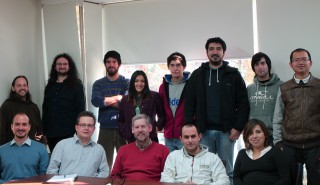Stellar Populations

The research area of Star Clusters and Stellar Populations started with the arrival of Douglas Geisler, PhD from the University of Washington (USA), to Concepción. He was also one of the co-founders of the Astronomy Department at the Universidad de Concepción. Today, the group consists of two professors, Geisler and Sandro Villanova, PhD from Università di Padova (Italy), several postdoctoral researchers, a number of graduate and undergraduate students, plus important international collaborators.
Recently, Dr. Villanova, as part of an international collaboration, made an important scientific contribution in the study of the abundance of Lithium in the Universe, related to the Lithium problem (for more details see News).
Dr. Geisler, Director of the Astronomy Department, is focused on the study of Multiple Populations (MP) in star clusters using both high-resolution spectroscopy as well as the broadband Washington filter system. Within a cluster, all stars should have the same age and chemical composition, having formed very quickly from the same molecular cloud. For many years, astronomers had thought that the composition of stars in clusters were the same and that all the stars had the same age, but in the 1970s they started encountering some anomalies, especially in Globular Clusters (old and massive star clusters). They found that stars with the same metallicity (heavy element content) within a cluster presented differences in their abundances of CN (carbon-nitrogen) and CH (carbon-hydrogen) bands. Nowadays, this phenomenon is known as Multiple Populations (MP). MP can be observed spectroscopically but this is time consuming and requires large telescopes. Astronomers now realize that observing with the right photometric filter can reveal MPs much more quickly and for many more stars. The key is to observe in the ultraviolet (UV). Photometry with filters like Johnson U (centered at 3570Å), Stromgren u (centered at 3537Å) and Sloan u (centered at 3600Å), have been widely used to discover and study the MP phenomenon because of these filter’s UV sensitivity. However, these filters present some practical limitations: they are not very broadband and their wavelength range, concentrated near the atmospheric cutoff (where no more light is allowed to pass due to the Earth’s atmospheric absorption), makes them very sensitive to both interstellar and atmospheric extinction, requiring substantial large telescope time or the Hubble Space Telescope (see fig. 1). Dr. Geisler realized that the Washington photometric system was actually designed to study MP, many years ago, even before this phenomenon was known to exist. This is due to the fact that the system includes a filter, designated C (for carbon), introduced to measure the CN/CH strength independently of metallicity. It is much broader than Johnson U or the Stromgren/Sloan u filters, allowing the same stars to be observed on much smaller telescopes, and is centered approximately at 4000A (much redward of the other filters), and is therefore less affected by atmospheric extinction and reddening, although it includes all of the CN and CH features that are crucial in distinguishing MPs.

Geisler and former UdeC postdoctoral researcher Jeffrey Cummings, along with S.Villanova and G. Carraro (ESO-Santiago), recently published their work (Cummings et al 2014, AJ 148:27), in which they studied the stellar populations of the globular cluster NGC 1851 using Washington photometry. “We confirmed the existence of Multiple Populations at the Red Giant Branch (RGB) and SubGiant Branch (SGB) and therefore proved that the Washington C filter is very effective at detecting MPs. In addition, we found a second population on the Main Sequence (MS) (see fig. 2), never seen before for this cluster. This is also the first time that MPs on the MS have been detected from the ground” explains Dr. Geisler. The novelty of their discovery is that all of the data were obtained using only the 1m SWOPE telescope, located at Las Campanas Observatory. Previous investigations had used either the HST or much larger telescopes and/or much longer integration times. This graphically proves the efficiency of this technique.
They have now extended their study of MPs to the Small Magellanic Cloud, which has a large number of clusters never before studied. They have obtained telescope time at the SOAR four meter telescope to gather photometric data. “Having shown this filter works for nearby clusters, in our own Galaxy, we want to use the efficiency of our technique to explore MPs in other galaxies. We are the only group in the world using the Washington filter system to study MPs in globular clusters” adds Geisler.





